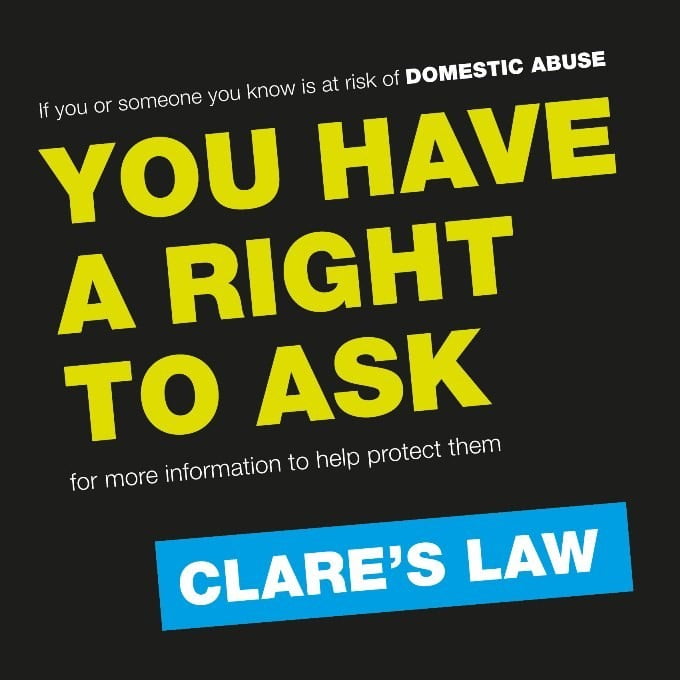A Safeguarding Hub – 25-minute read
In November last year the BBC ran a news story titled “Clare’s Law: The women who risk their lives by refusing information”. The article focussed on the Domestic Violence Disclosure Scheme (DVDS), also known as Clare’s Law. This scheme affords a person the ‘right to ask’ the police if their partner may pose a risk of domestic abuse to them. It also provides the police with the authority to share information where they feel that there is a risk to that person, known as the ‘right to know’. There were two threads to the BBC story, the first suggesting Clare’s Law is underused by women, even when they are approached by the police, the second highlighting that many applications end in non-disclosure.
To emphasis the second point, the BBC included the 2018 figures from the Office of National Statistics (ONS), revealing that less than 44% of “right to ask” applications end in disclosure of information (2,055 out of 4,655). The disclosure rate for “right to know” applications is a little better at 57% (3,594 out of 6,313). The article suggests that the reason the non-disclosure rate is so low, is that many women refuse to have the information shared with them. To highlight this point, the BBC turned to a retired police officer who offered an opinion suggesting that in ‘right to know’ cases, many women simply do not want the police interfering. They backed this up with results from Freedom of Information (FOI) requests they sent to all police forces in England and Wales, asking the reasons for non-disclosure. The BBC said that the responses they received, support the view that “in a number of cases, women are refusing to engage with police”. If the intended recipient refuses to hear the information, then this is recorded as a non-disclosure.
There is no doubt that the number of applications should be higher. The ONS figures show that in the year ending March 2018, an estimated 2.0 million adults aged 16 to 59 years had experienced domestic abuse in the last year (1.3 million women, 695,000 men). The number of applications under both the right to ‘ask’ and ‘know’ is not proportionate to the estimated number of people suffering domestic abuse. Why is that?
There will always be a high rate of refusals because there are a number of complex reasons why people experiencing domestic abuse don’t seek out or accept help immediately, sometimes never. Research shows that many people live with domestic abuse for a significant time before seeking help. The domestic abuse charity SafeLives produced some data in 2015 which suggested that on average a high-risk victim lives with domestic abuse for 2.3 years and medium risk victim for 3 years, before getting help. They also reported that “on average victims experience 50 incidents of abuse before getting effective help”.
However, in our view Clare’s Law is something that can stand alone from these figures. It is available to various people, those who may have an indication that something is not right in a new relationship, people who are entering a new relationship and want to make sure they are doing the right thing; and of course those who are experiencing domestic abuse. It empowers a person to seek information and does not necessarily means someone wants or is ready to accept help. Therefore, we feel the real issue is not the number of refusals, but the low number of referrals, 0.5% based on the estimated numbers of incidents.
One of the problems lies with the accessibility issue. Many people will be put off by the thought of going into police buildings to begin the process. Thankfully this particular problem will be addressed as more and more forces enable the initial stage of Clare’s Law to be completed online. Another issue lies with the fact that the scheme is not routinely publicised by the government or police forces, so many potential applicants simply do not know that it exists. Amongst many frontline police officers, Clare’s Law is not an area which gets any significant input or training, with knowledge generally limited to specialist units. Only 6,313 ‘right to know’ submissions in 2018 suggests that amongst the police it is underused. However, looking at the bigger picture, figures seem to suggest that there is disparity in how the scheme is approached across the UK. The best performing constabulary was Cumbria, having disclosed 245 of their 256 cases (96%), whilst at the bottom of the league table were:
- Bedfordshire – 3 disclosures/38 requests (7%),
- Northumbria – 25/273 (9%)
- Essex – 121/452 (9%)
It is easy to blame police forces, but this isn’t just the fault of police. All cases under the DVDS should go in front of a multi-agency panel for discussion, and the police are then advised whether to disclose. So, the inconsistency in disclosure seems to suggest that there is a disparity in knowledge within other agencies as well.
In our view all professionals involved in safeguarding should wherever possible highlight the existence of Clare’s Law, particularly if they work in a field of safeguarding where there is potential to come in contact with victims of domestic abuse. To do that professionals should have at the very least, a basic understanding of the DVDS and the process. The government guidance is lengthy but presented in a very simple and easy to follow format. Below we have tried to summarise, and bullet point the main parts, but for completeness we recommend you refer to the government guidance.
The official name for Clare’s Law is the Domestic Violence Disclosure Scheme (DVDS). Simply put it means that any member of the public has the right to ask the police if their partner might pose a risk to them, by gaining access to their partners relevant criminal history. This also applies to ‘third-party’ members of the public who are able to make enquiries about the partner (or potential partner) of a family member or close friend. This is known as a ‘right to ask’. There is also a ‘right to know’ part of the scheme which places a risk management responsibility on safeguarding agencies, where they come into possession of information about the previous violent and abusive behaviour of someone who may potentially cause harm to a current partner.
Whether it is a right to ask or know, the safeguarding agencies have to assess the risk and determine whether any disclosure should be made to protect a person who may be at risk of harm from domestic violence or abuse. The agencies will look at whether the partner (or prospective partner) has a conviction, caution, reprimand, or final warning for violent or abusive offences. If, following a risk assessment process, the safeguarding agencies reasonably believe that the partner poses a risk of harm to the person, then they can disclose information to the person at risk. Where a decision is made to disclose, it needs to it is lawful e.g. necessary and proportionate.
The DVDS is named after Clare Wood who was murdered in February 2009.
In April 2007, 36-year-old Clare from Salford, Greater Manchester, met a man called George Appleton on an internet dating site. Clare was aware that he had a criminal record, but she believed it was only for motoring offences. On 2nd October 2008, Clare ended the relationship after she found out that he was having affairs with several other women. A few days later Clare reported to the police that Appleton had threatened to burn her house down and have her stabbed. The following day he attended her house and began banging on the front door. Clare rang the police and Appleton was later arrested at his home address on suspicion of criminal damage. He was released on bail with conditions not to contact Clare or go to her street.
It wasn’t until 28th December that police managed to speak to Clare. She told them that she believed Appleton no longer posed a threat and he had not been in contact with her. For some reason on 6th January he was bailed again, but his bail conditions were relaxed and the restriction about attending her street was withdrawn. On 18th January, Clare contacted police and said she had been sexually assaulted by Appleton. The following day he was arrested, interviewed and denied the allegation. He was bailed until April 20th. On January 20th Clare reported that Appleton had contacted her via social media and three days later he was arrested at his home for breaching his bail. However, he was de-arrested as the breach was deemed minor and non-threatening by the officers dealing.
During a video-interviewed regarding the allegation of sexual assault, Clare admitted that following her initial allegation she had contacted Appleton and that they had had contact on several occasions, including voluntarily attending his flat on January 17th. A file relating to original allegations of threats to burn her house down and criminal damage, was submitted to the CPS, but did not include the allegation of sexual assault. On 30th January, following advice from the CPS, Appleton was issued with a fixed penalty notice for causing criminal damage. The CPS had also advised that he be issued with a warning under the Protection from Harassment Act, but this didn’t happen.
On February 2nd, Appleton attended Clare’s home address, battered and strangled her to death, then set fire to her body. She was found 4 days later by her ex-husband after Clare’s father became worried about the lack of contact from her. Police began a manhunt and six days later Appleton’s body was found in a derelict pub a short distance from Clare’s home. He had taken his own life. An investigation by the Independent Police Complaints Commission (IPCC) later criticised the way the police had handled the case.
Following Clare’s murder, it became known that Appleton’s offending history just didn’t relate to motoring offences. He was also known for violent offences against women, including harassment, assaults and specifically kidnapping one ex-girlfriend at knifepoint. Clare’s father Michael was connived that if Clare had known this about Appleton at an early stage, the relationship may well not have developed. Michael, together with a number of other people, began a campaign calling for on a system to be put in place to allow people to find out whether their new partners had a violent past. The campaigned was supported by many, including the Association of Chief Police Officer’s (ACPO), the Coroner at Clare’s inquest and the Victims' Commissioner. Eventually in July 2012, the then Home Secretary Theresa May launched Clare’s Law as a pilot in four police forces. Following the successful pilot, the DVDS was launched across England and Wales on 8th March 2014, International Women's Day. The law was adopted in Scotland the following year.
There are two procedures under the DVDS:
- the ‘right to ask’, triggered by a member of the public applying to the police for a disclosure.
- the ‘right to know”, triggered by the police making a proactive decision to disclose information to protect a potential victim.
In both cases the police and other safeguarding agencies will carry out checks and where necessary the police have common law powers to disclose information about a person’s known history of violence or abuse. They can do this if it is necessary and proportionate in order to prevent further crime. Whilst actual disclosure falls to the police, it is generally a multi-agency panel that decides whether the risk is sufficient to warrant disclosure.
Anyone has the right to ask and submit an application. This includes where a person asks, because they believe that their friend or relative might in a relationship with a potentially abusive partner. However, generally any disclosure will only be made to the person in the relationship i.e. the person at risk. The same principle applies to the ‘right to know’. There may be some occasions where disclosure might be made to a third party if they are best placed to safeguard the person at risk e.g. a third-party sector worker.
How a police force accepts initial contact from a person wanting to make an application, varies between police areas. The main route for the applicant is to attend a police officer building or station. When Clare’s Law was originally introduced some forces decided that it had to be done in person. This was done for a number of reasons, one of them being so that a police officer or member of police staff could make an assessment as to whether the person needed immediate help. However, as mentioned earlier, some forces now make Clare’s Law available as an online application and there are plans afoot to make online submission, accessible nationally.
Another route is via the police contact centre or where front -line police officers and police community support officers are approached in the course of their normal policing duties. Officers should have an awareness of the DVDS and should be able to signpost the member of public to that particular forces access point. If the applicant visits a police station in person, then any referral must take place in private and not in a public part of the building. On initial contact the applicant will need to provide certain details which include:
- name, address, date of birth and other basic detail about the applicant
- preferred method of contact
- details of the person (subject) they are enquiring about e.g. name, date of birth, address and other personal detail (if able)
- details of the person at risk (if not the applicant)
- details of any children
- nature of the relationship between the subject and the person at risk
- what the concerns are around the person at risk e.g. the reason why they are making the application
During the initial contact stage, the officer should make the applicant aware of certain information, which should be read to them. This includes:
- disclosure will only be given to person at risk and/or a person who is in a position to safeguard the person at risk
- the applicant will require proof of ID
- the DVDS does not replace existing procedures that are currently in place for subject access or Freedom of Information (FOI) requests and the Disclosure and Barring Service (DBS)
- an initial assessment will be completed to establish whether there is an immediate or imminent risk of harm
- that should a decision be made to progress the disclosure application further; the application will be referred to appropriately trained staff to progress
- the applicant will be required to undertake a face to face meeting within the next 10 working days
They should also be given the timescales for the application:
- 24 hours for checks to eliminate immediate risk
- 10 days for a face-to-face meeting
- 35 days for the completion of the enquiry – disclosure/non-disclosure
Following initial contact with the applicant the police should:
- carry out intelligence checks on all persons involved – to inform the risk assessment
- complete an initial risk assessment
- decide whether or not to progress the disclosure application (based on the initial information, intelligence checks and risk assessment)
If the police decide that the disclosure application should continue, the applicant must be seen in a face-to-face meeting.
The purpose of the face to face meeting is to ensure the application is genuine and not malicious, and also to establish further details about the application to assess risk and whether the application should be progressed. During the meeting the applicant should be told:
- that their identification will need to be verified
- that if they wilfully or maliciously provide false information to the police in order to try and get a disclosure they are not entitled to, they may risk prosecution
- that any information disclosed by the police must only be used in order to safeguard the person at risk
- that the application will be dealt with confidentially. However, the applicant should also be told that part of the process is that the police must consider whether they should seek representations from the person whom the applicant is concerned about. They must also be told that if the final decision is to disclose information, then the police will also have to consider whether they should tell the person that information about them is going to be disclosed.
- that they will be required to sign an undertaking that they agree that the information is confidential, and they will not disclose this information further
- that if they disclose and confidentiality is breached, then they may breach the Data Protection Act 1998
- that if they disclose evidence of an offence whilst registering a concern, it may not be possible to maintain their confidentiality
Our view: in the government guidance the information above is termed as ‘the applicant should be warned’. There are an awful lot of warnings and undertakings. At this stage the applicant is likely to heading for the door, petrified that the very person they want disclosure on, may well be told about the process. This is particularly relevant if the applicant isn’t a concerned third party, but potentially the person at risk. For many people this may well complicate an already difficult and potentially dangerous situation. Will there be any reprisals from their partner or prospective partner if they find out that there are doubts about them, or that they are ‘under suspicion’?
This is where it is important that the face to face meeting is done with a police member of staff that is skilled in dealing with domestic related issues and has a sound knowledge of the procedures relating to Clare’s Law. How these warnings are delivered may well be vital to whether the applicant proceeds or not. There needs to be some ‘flesh on the bones’, an explanation that the whole process is about the safety of the person who is potentially at risk. It is essential that the applicant should also be aware that when the decision makers are considering whether to disclose information to a potential perpetrator, they also assess whether disclosure “would have the potential to escalate the risk of harm”. If the answer to that is yes, then the potential perpetrator should not be told.
Timeline: the face-to-face meeting should take place as soon as practicable, but no later than 10 working days after the initial contact.
This is where the police receive indirect information that a person may be at risk. This is likely to occur when the police are dealing with an incident between person in a relationship. Generally, this will be domestic related, either a criminal allegation or a non-crime domestic incident. They may also receive information about a person from a partner agency or a non-government voluntary organisation, via agreed safeguarding protocols or within safeguarding meetings.
The process for the right to know route does not differ from the right to ask, other than there is no applicant and therefore no face to face meeting.
Following their checks, risk assessment and face to face (right to ask only), the police should be in a position to reach a decision as to whether there is a ‘credible risk of harm’ to a person, in the form of violent and abusive offending and/or behaviour. The police should then classify the disclosure application (right to ask) or the indirect information (right to know) as either a ‘concern’ or ‘no concern’. Once they have done this, the case is then referred to the local multi-agency forum for consideration.
A concern arises if it appears that a person is at risk from a potential offender because:
- he/she has convictions for an offence related to domestic violence
- he/she is a serial perpetrator of domestic violence
- there is concerning behaviour by he/she demonstrated towards the person at risk e.g. stalking or coercive controlling behaviour
- intelligence shows that he/she has previous violent and abusive offending e.g. cases not proceeded with, previous concerning behaviour towards previous partners
A no concern is where there is no information available that would indicate a risk.
At this point the police must now refer the case to a local multi-agency panel for a final decision as to whether information should or should not be disclosed. This includes ‘no concerns’ assessments.
Timeline: this stage should be achieved no later than 5 working days from the face to face meeting (right to ask) or from receipt of the indirect information (right to know).
Whilst the final decision around disclosure is always a police decision, the case should be referred to a local multi-agency panel. Their role is to discuss the case and advise the police around the final decision – disclose or not disclose. The panel must consider three principles when debating:
- the three-stage disclosure test for police (see below)
- the eight principles contained with the Data Protection Act 1998
- whether they should tell the person who is subject of the concern (the partner or potential partner)
The three-stage test under Principle 1 is:
- it is reasonable to conclude that such disclosure is necessary to protect a person from being the victim of a crime
- there is a pressing need for such disclosure
- interfering with the human rights of the person who is the subject of concern (the partner or potential partner) is necessary and proportionate for the prevention of crime
Timeline: the local multi-agency forum should consider the referral no later than 20 working days after the categorisation of the “concern” or “no concern” has been made by the police.
If the decision is that information will be disclosed to the person at risk of harm or other person who is better best placed to safeguard the person at risk, then the following should be considered:
- what information should be disclosed and the specific wording of the disclosure
- who the disclosure should be made to e.g. the person at risk of harm or other person who is better best placed to safeguard the person at risk?
- how the disclosure should be made, e.g. whether any other agencies should be present with the police, when the disclosure is made
There is a set wording that must be read to the person receiving disclosure. They will be told that the information must only be used for the purpose for which it has been shared i.e. safeguarding. They will be asked to sign an undertaking that they agree that the information is confidential, and they will not disclose this information further. They should also be warned that legal proceedings could result if this confidentiality is breached. The government guidance gives direction if a person is not willing to sign an undertaking.
The following actions should be completed:
- rationale for no-disclosure should be recorded
- the applicant should be told that there is no information to disclose
- the applicant should be told in person
- that the lack of information to disclose does not mean that there is no risk of harm – advice should be given to the applicant about future safety
- they should be provided with safeguarding information and sign-posted to relevant support services
In the event that the person of concern is told that a disclosure is to be made about them, they should be informed in person, provided with information about the DVDS and told of the implication.
There are a number of safeguards throughout the process:
- at any stage during the initial contact the police believe that the applicant is alleging a crime, rather than just asking for information, they must deal with the crime and begin an investigation. This does not prevent the DVDS process from progressing
- a safe means of contacting the applicant will be established from the outset
- police should provide safety advice e.g. if a person has accessed the process online, then advice might include, how to hide your web browsing history
- no written correspondence should be sent to the applicant
- a risk assessment should be completed at every stage of the process, so as to safeguard any potential victim
- if at any stage of the process an immediate risk is identified, then safeguarding action must take place and a robust safety plan put in place
- a safety plan should be put in place when disclosure is made to the person at risk
- sign-post to local support services where relevant
There has been some criticism of the DVDS. A 2016 report by Dr Kate Fitz-Gibbon and Professor Sandra Walklate, titled ‘The Efficacy of Clare’s Law in Domestic Violence Law Reform in England and Wales’, looked at some of the potential issues. These included questioning the effectiveness of the scheme and the suggestion that it could potentially exacerbate the situation for women living with violence. Other critics highlight that there is a massive trust issue to overcome, not only towards the police, but social services in cases where children are involved. All are valid points. Trust and reprisal are huge issues for people who live with domestic abuse.
Clare’s Law will never have any significant impact on reducing overall incidents of domestic abuse in the UK. Some argue that it is ineffective as a prevention tool, but we disagree. Whilst its use is never likely to be widespread, it provides a valuable choice to the few. On this basis alone we as safeguarding professionals should ensure that we highlight it as an option, to those that may well need it. It is then up to the individual to exercise their right to use it.
Thanks for reading

Get Involved!
Share Your own Safeguarding News and Research to reach a wider Audience
From Our Blog
Sextortion – Guide and Resources
Sextortion – a guide and links to useful resources.
Dementia – Sundowning
For most people the end of British Summer Time signals the start of the long dark British winter. For many living with dementia, the clocks turning back an hour can affect routine, one of the possible causes of a pattern of behaviour known as ‘Sundowning’. This can potentially cause a person with dementia to wander and subsequently go missing.
Bullying, sexting and sexual exploitation are not the only online dangers!
Cyber bullying and online sexual exploitation are not the only dangers that lurk on the world wide web for children. Here we look at some of the other safeguarding risks that young people may be exposed to.
Age related milestones relevant to safeguarding children
Age related milestones that are relevant to safeguarding children – a guide.
Related Posts
The Safeguarding Hub
Share Your Safeguarding News And Research To Reach A Wider Audience









